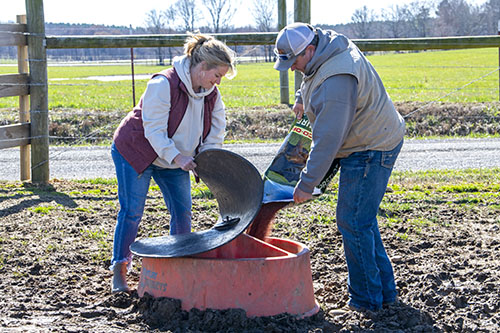National Agriculture Week
Mar 20, 2023

By John Houston, ProTrition Director of Business Services
Happy National Agriculture week!
As I begin this blog, I must give thanks to the industry of agriculture. I have been blessed to be involved in agriculture in some form all my life. For the last 34 years, my professional career in agriculture has allowed me to work with the very best producers, educators, students, and industry professionals. The agriculture industry is overwhelmingly a tight-knit group. No matter what sector of agriculture you are involved in, everyone knows and respects each other. That makes agriculture an amazing industry. Furthermore, working in agriculture allows us to provide for the basic needs of life. Agriculture touches us all from daily food, clothing, fuel, cosmetics, and medications to even the football used in the super bowl.
As we think about agriculture this week and meditate on its importance in our life, let me provide you with some very basic facts that, quite frankly, are often misrepresented.
For example, an American farmer feeds 144 people worldwide. Meats of all kinds are an essential part of a balanced diet because they are nutrient dense and are considered complete proteins. All nine of the essential amino acids needed by humans are found in these products. Remember that protein is essential to the human body for specific functions. The current United States Department of Agriculture recommendation for the consumption of protein is 63 grams a day for adult men and 50 grams a day for adult women.
A 2006 Food and Agriculture Organization of the United Nations report estimated total greenhouse gas emissions (GHG) resulting from animal agriculture around the world. These numbers are misleading in the U.S. because the vast majority of global GHG emissions attributed to livestock production result in converting rainforests and other lands to grow crops or pasture. In large part, these changes do not occur in the U.S. The U.S. has seen an increase in the total acreage of forested land over the last several decades, but total agriculture production has increased.
U.S. dairy farmers’ GHG emissions decreased by almost 32%. This decrease has not influenced production as milk production was up by almost 60%. GHG emissions per dairy cow dropped by almost 66%.
The animal agriculture industry continues its responsibility to be stewards of the land and continues to work diligently in protecting the environment while increasing production to feed the rapidly growing population of quality protein products.
As we celebrate the industry that sustains us all, let’s be aware of the facts. Animal agriculture provides safe and nutritious products to our tables. How can I be sure? Livestock producers eat, too. No livestock producer I know would provide something to the food chain that wasn’t safe for their own family to consume.
The U.S. has the most abundant, safest, and least expensive food supply in the world. Let’s celebrate!
For more content like this, check out the latest issue of The Cooperator.
Happy National Agriculture week!
As I begin this blog, I must give thanks to the industry of agriculture. I have been blessed to be involved in agriculture in some form all my life. For the last 34 years, my professional career in agriculture has allowed me to work with the very best producers, educators, students, and industry professionals. The agriculture industry is overwhelmingly a tight-knit group. No matter what sector of agriculture you are involved in, everyone knows and respects each other. That makes agriculture an amazing industry. Furthermore, working in agriculture allows us to provide for the basic needs of life. Agriculture touches us all from daily food, clothing, fuel, cosmetics, and medications to even the football used in the super bowl.
As we think about agriculture this week and meditate on its importance in our life, let me provide you with some very basic facts that, quite frankly, are often misrepresented.
For example, an American farmer feeds 144 people worldwide. Meats of all kinds are an essential part of a balanced diet because they are nutrient dense and are considered complete proteins. All nine of the essential amino acids needed by humans are found in these products. Remember that protein is essential to the human body for specific functions. The current United States Department of Agriculture recommendation for the consumption of protein is 63 grams a day for adult men and 50 grams a day for adult women.
A 2006 Food and Agriculture Organization of the United Nations report estimated total greenhouse gas emissions (GHG) resulting from animal agriculture around the world. These numbers are misleading in the U.S. because the vast majority of global GHG emissions attributed to livestock production result in converting rainforests and other lands to grow crops or pasture. In large part, these changes do not occur in the U.S. The U.S. has seen an increase in the total acreage of forested land over the last several decades, but total agriculture production has increased.
U.S. dairy farmers’ GHG emissions decreased by almost 32%. This decrease has not influenced production as milk production was up by almost 60%. GHG emissions per dairy cow dropped by almost 66%.
The animal agriculture industry continues its responsibility to be stewards of the land and continues to work diligently in protecting the environment while increasing production to feed the rapidly growing population of quality protein products.
As we celebrate the industry that sustains us all, let’s be aware of the facts. Animal agriculture provides safe and nutritious products to our tables. How can I be sure? Livestock producers eat, too. No livestock producer I know would provide something to the food chain that wasn’t safe for their own family to consume.
The U.S. has the most abundant, safest, and least expensive food supply in the world. Let’s celebrate!
For more content like this, check out the latest issue of The Cooperator.